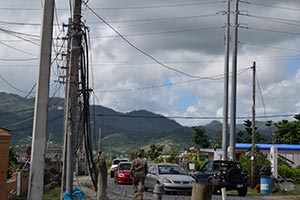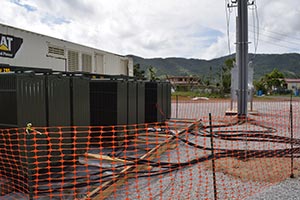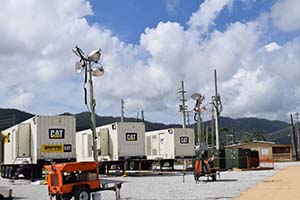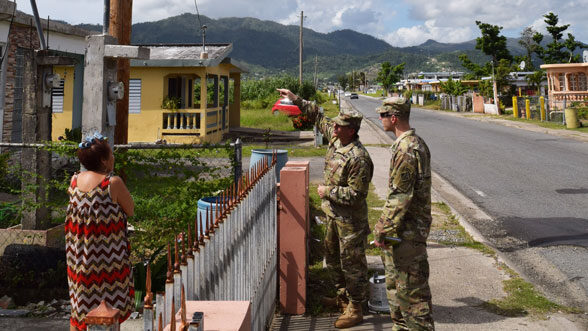Power to the people

USACE Task Force Power Restoration Commander Col. John P. Lloyd (foreground) and TF Power Operations Officer Capt. Aaron Anderson survey the damage wrought by Hurricane Maria as they walk through a neighborhood in Maunabo, Puerto Rico, on Jan. 3. (Photo Credit: U.S. Army photo by Gerald Rogers.)
Electrical posts, the lines still attached, lie on the ground next to the road. They are piled with debris that’s been pushed aside so vehicles may pass. On the hills, vegetation, uprooted or snapped in half by the category 4 hurricane that hit Puerto Rico in September, has started to come back. Such resilience offers a glimpse of hope amid a devastating scenario in which more than 3 million Puerto Ricans have lived since Hurricane Maria.
“I don’t think you can be prepared for what you’re going to see,” says Capt. Aaron Anderson, MS ’16, an operation officer with the U.S. Army Corps of Engineers (USACE) Task Force Power Restoration. “You go up in the mountains and the destruction is just . . . monumental.”
Anderson arrived in Puerto Rico shortly after Thanksgiving to begin the process of rewiring the storm-ravaged island. He spent six weeks in the U.S. territory setting up microgrids to temporarily power areas left in the dark since the Sept. 20 storm.
“If this happened on the continent, it would be devastating,” he says. “The fact that it happened on the island makes it 10 times more challenging.”
Damage control

Large transformers, along with 1,850-kilowatt generators form the microgrid system, provide temporary power to Maunabo, Puerto Rico, until the main grid is back online. (Photo Credit: U.S. Army photo by Gerald Rogers.)
According to the U.S. Department of Energy, power has been restored to nearly 86 percent of the island’s residents. Yet some 2 million people still live in areas at risk of water contamination.
“When you’re without power for a day, it’s a big deal,” Anderson says. “They have been without power for [five months]. People there, they don’t let their spirits get down. They are very resilient. I have nothing but love and respect for the people of Puerto Rico.”
Power supply — and lack thereof — has become an increasingly politicized issue in the storm’s aftermath. In January, Gov. Ricardo Rosselló (also a Michigan alumnus, MSE ’03/PhD ’07), announced the privatization of the power company, Puerto Rico Electric Power Authority (PREPA). The utility entered Title III bankruptcy proceedings in July 2017; it has approximately $9 billion in outstanding debt.
The storm’s damage added new layers of complexity to the already troubled economy; last May the territory filed for bankruptcy protection after defaulting on its $73-billion debt. The slow disaster response from the federal government and ongoing financial crisis on the island has fueled calls by some, including members of Rosselló’s party, to rally for statehood while other political groups seek to maintain independence.
Lights on

This microgrid temporary power system supplies critical power in Maunabo, Puerto Rico. (Photo Credit: U.S. Army photo by Gerald Rogers.)
Still, the work continues. The Task Force Power Restoration works closely with local mayors, FEMA, and PREPA to identify and prioritize areas that could most benefit from the temporary electric grid. Crews assess such factors as population and whether electricity is needed to power nearby hospitals and water supply infrastructure. The first microgrids were installed in Isla Culebra, with additional microgrids in Patillas, Maunabo, Naguabo, and Yabucoa, on Puerto Rico’s southeast side.
The diesel-powered generators are the size of semi-trailers, Anderson says. And it’s risky business connecting them to the transformers and substations. Since the system has been down for so long, it has to be turned back on in stages.
“You have to find the faults and build up the system from there,” Anderson says. “If you turn on the system all together, some of this equipment . . . it would literally blow things up.
“I’m going to be the happiest person in the world when I’m out of a job, because it will mean the people in Puerto Rico don’t need back-up power anymore, that the main grid is restored.”




Antonio Jesurun - 1970
Makes you appreciate what you have. I have cousins in PR who were w/o power for 3 months. Getting water was difficult as well.
The Puerto Ricans there are very resilient people but have suffered more than they should have.
As a US Commonwealth (territory) they deserved more help than they were given.
Reply
Patrick CARDIFF - 1990
I wish the author would have been a little more *realistic* about the facts. It’s been about 5 months now since Maria and FEMA involvement wasn’t so in-and-out.
I went to PR as an “other agency” volunteer, and what I saw was too many groups trying to accomplish too many things. It was a bureaucratic nightmare, frankly.
The people needed clean drinking water and electricity the most. That meant these activities should have been prioritized, along with debris removal, which was hampering transportation and access to house inspections. And yes, utilities services were not stellar before the hurricane.
Instead too many groups were literally falling all over themselves to accomplish their own agendas.
That, and a general “militaristic” stance of FEMA created resentments in a number of quarters.
People want to know, and it has to be genuine, that they are being served. Government bureaucracy is *no way* to deal with disaster. I believe this was the biggest impression I got. That, and security concerns were too weighty and restrictive overall.
Reply